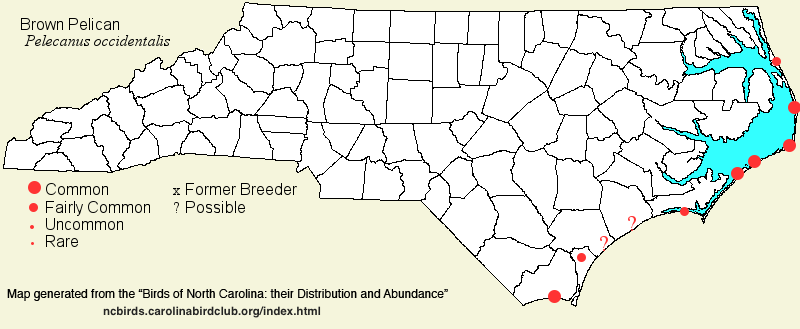 |  |
|
Brown Pelican - Pelecanus occidentalis PELECANIDAE Members: | Search Common: Search Scientific: |
|
|
|||||||
| General Comments | This species is one of the most familiar of all of the state's birds to the layman, as everyone knows and can identify a Brown Pelican. As with a number of our other Pelecaniform species, Brown Pelicans are showing a remarkable increase in numbers over the past few decades. For many decades in the mid 20th Century, the species bred in the state at just one set of islands in Ocracoke Inlet, even though coastal sightings were not uncommon. Even through the 1970's, the species could be hard to find in winter along the northern coast, and large numbers died of starvation or cold weather during the often brutal winters of the 1970's. However, warmer winters since 1980 have helped annual survival, and continued management of coastal estuarine islands, often with dredged sand deposited for colonial nesting waterbirds, has helped the pelican spread as a breeder. The species has been nesting on roughly 10 sites along the coast in the past decade, putting it out of immediate danger as a breeding species; it is no longer State listed. Unlike the American White Pelican, which often feeds on fresh water, the Brown Pelican is almost strictly a salt/brackish species, though it may occasionally be seen at a few coastal impoundments and at lakes far inland. | ||||||
| Breeding Status | Breeder | ||||||
| NC BRC List | Definitive | ||||||
| State Status | SR | ||||||
| U.S. Status | |||||||
| State Rank | S2B,S4N | ||||||
| Global Rank | G4 | ||||||
| Coastal Plain | Permanent resident, with migratory movements; breeding. Common to very common, though local, breeder and year-round resident, with numbers slightly less in winter, especially along the northern coast, though still fairly common there in midwinter. Fairly common to common in the tidewater areas, at least in salt/brackish waters; much less numerous in fresh water areas. Peak coastal counts: 5,000, Hatteras Inlet, 30 Dec 1998. Very rare visitor far inland, late Jun to late Mar. Peak inland count: 11, Greenville, 28 Jan 1993. | ||||||
| Piedmont | Very rare visitor. At least 28 reports, mostly at large reservoirs (about one-third of these from Falls Lake), mainly mid-Jun to early Dec. One far west at Robinwood Lake (Gaston) on 16 Dec 2017 was quite exceptional for that season. The only other Piedmont winter record seems to be one at Parkwood Lake (Durham) from 10-17 Feb 2024. An early date seems to be one at Lake Townsend (Guilford) on 3 May 2022. Peak counts: 9 in flight over Falls Lake, 16 May 2014; 3, Lake Lure (Rutherford), 28-31 May 2022; 3, Lake Hickory (Catawba), 7 Jun 2022, which might have been the same birds as noted a few days earlier at Lake Lure; all others are of single birds. | ||||||
| Mountains | Accidental/casual. Four reports (all single birds); Waynesville, 6 Aug 1979; Lake Junaluska (Haywood), 31 May - 10 Jun 2003; Price Lake (Watauga), 20 May 1994; and Lake Julian (Buncombe), 12 Jun 2023. | ||||||
| Finding Tips |
None needed; easily found along and near coastal areas. **** | ||||||
| Attribution | LeGrand[2025-04-21], LeGrand[2025-02-03], LeGrand[2024-05-13] | ||||||
| NC Map Map depicts all counties with a report (transient or resident) for the species. | Click on county for list of all known species. |
| NC Breeding Season Map Map depicts assumed breeding season abundance for the species. |  |